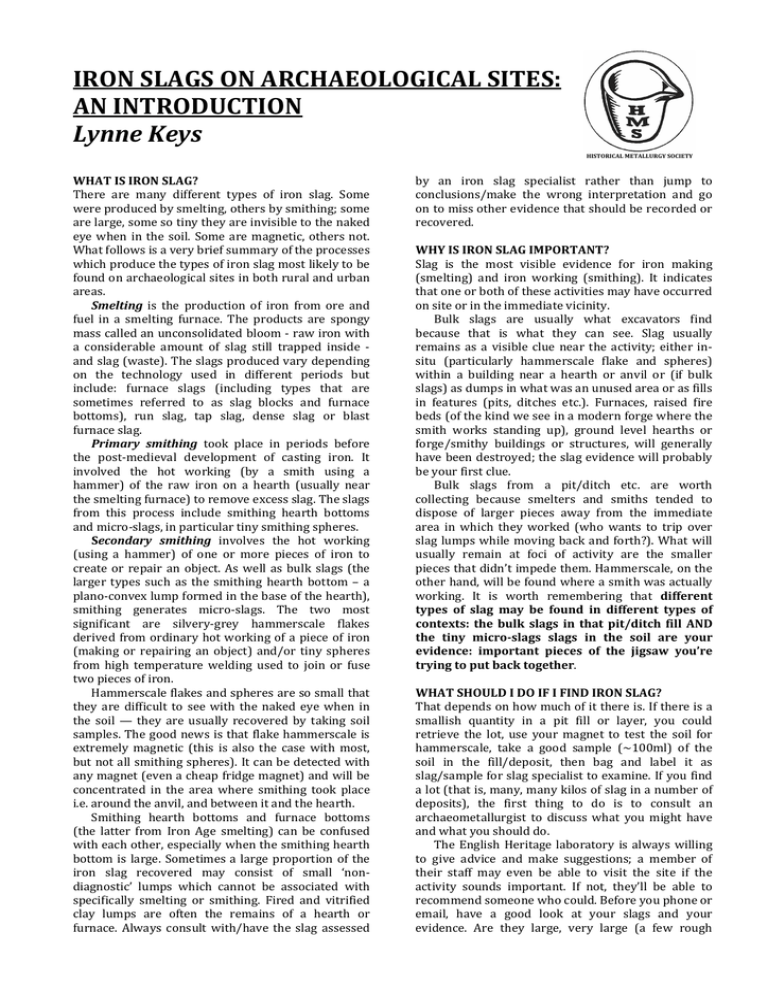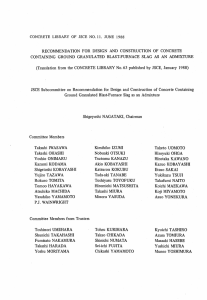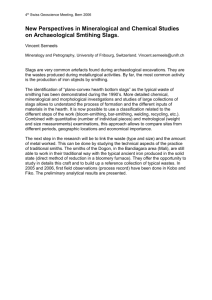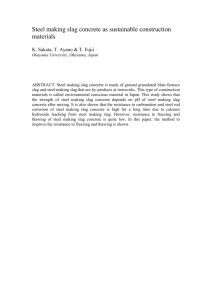IRON SLAGS ON ARCHAEOLOGICAL SITES
advertisement

IRON SLAGS ON ARCHAEOLOGICAL SITES: AN INTRODUCTION Lynne Keys WHAT IS IRON SLAG? There are many different types of iron slag. Some were produced by smelting, others by smithing; some are large, some so tiny they are invisible to the naked eye when in the soil. Some are magnetic, others not. What follows is a very brief summary of the processes which produce the types of iron slag most likely to be found on archaeological sites in both rural and urban areas. Smelting is the production of iron from ore and fuel in a smelting furnace. The products are spongy mass called an unconsolidated bloom ‐ raw iron with a considerable amount of slag still trapped inside ‐ and slag (waste). The slags produced vary depending on the technology used in different periods but include: furnace slags (including types that are sometimes referred to as slag blocks and furnace bottoms), run slag, tap slag, dense slag or blast furnace slag. Primary smithing took place in periods before the post‐medieval development of casting iron. It involved the hot working (by a smith using a hammer) of the raw iron on a hearth (usually near the smelting furnace) to remove excess slag. The slags from this process include smithing hearth bottoms and micro‐slags, in particular tiny smithing spheres. Secondary smithing involves the hot working (using a hammer) of one or more pieces of iron to create or repair an object. As well as bulk slags (the larger types such as the smithing hearth bottom – a plano‐convex lump formed in the base of the hearth), smithing generates micro‐slags. The two most significant are silvery‐grey hammerscale flakes derived from ordinary hot working of a piece of iron (making or repairing an object) and/or tiny spheres from high temperature welding used to join or fuse two pieces of iron. Hammerscale flakes and spheres are so small that they are difficult to see with the naked eye when in the soil — they are usually recovered by taking soil samples. The good news is that flake hammerscale is extremely magnetic (this is also the case with most, but not all smithing spheres). It can be detected with any magnet (even a cheap fridge magnet) and will be concentrated in the area where smithing took place i.e. around the anvil, and between it and the hearth. Smithing hearth bottoms and furnace bottoms (the latter from Iron Age smelting) can be confused with each other, especially when the smithing hearth bottom is large. Sometimes a large proportion of the iron slag recovered may consist of small ‘non‐ diagnostic’ lumps which cannot be associated with specifically smelting or smithing. Fired and vitrified clay lumps are often the remains of a hearth or furnace. Always consult with/have the slag assessed HISTORICAL METALLURGY SOCIETY by an iron slag specialist rather than jump to conclusions/make the wrong interpretation and go on to miss other evidence that should be recorded or recovered. WHY IS IRON SLAG IMPORTANT? Slag is the most visible evidence for iron making (smelting) and iron working (smithing). It indicates that one or both of these activities may have occurred on site or in the immediate vicinity. Bulk slags are usually what excavators find because that is what they can see. Slag usually remains as a visible clue near the activity; either in‐ situ (particularly hammerscale flake and spheres) within a building near a hearth or anvil or (if bulk slags) as dumps in what was an unused area or as fills in features (pits, ditches etc.). Furnaces, raised fire beds (of the kind we see in a modern forge where the smith works standing up), ground level hearths or forge/smithy buildings or structures, will generally have been destroyed; the slag evidence will probably be your first clue. Bulk slags from a pit/ditch etc. are worth collecting because smelters and smiths tended to dispose of larger pieces away from the immediate area in which they worked (who wants to trip over slag lumps while moving back and forth?). What will usually remain at foci of activity are the smaller pieces that didn’t impede them. Hammerscale, on the other hand, will be found where a smith was actually working. It is worth remembering that different types of slag may be found in different types of contexts: the bulk slags in that pit/ditch fill AND the tiny micro­slags slags in the soil are your evidence: important pieces of the jigsaw you’re trying to put back together. WHAT SHOULD I DO IF I FIND IRON SLAG? That depends on how much of it there is. If there is a smallish quantity in a pit fill or layer, you could retrieve the lot, use your magnet to test the soil for hammerscale, take a good sample (~100ml) of the soil in the fill/deposit, then bag and label it as slag/sample for slag specialist to examine. If you find a lot (that is, many, many kilos of slag in a number of deposits), the first thing to do is to consult an archaeometallurgist to discuss what you might have and what you should do. The English Heritage laboratory is always willing to give advice and make suggestions; a member of their staff may even be able to visit the site if the activity sounds important. If not, they’ll be able to recommend someone who could. Before you phone or email, have a good look at your slags and your evidence. Are they large, very large (a few rough measurements are useful), concave‐convex in shape, runny, flowed (lava‐like), brittle. Are the light or heavy (relative to the same size of brick)? What colour are they (black, grey, blue, green, yellow, cream, etc)? Do they have charcoal or coal inclusions or large voids from burnt‐out inclusions? Test your slag deposits with a magnet (but put it inside a small plastic bag before use it or you may have trouble removing fragile hammerscale intact from the magnet). When you contact an archaeometallurgist you should mention the types of features in which slag is being found and whether there is any other potential evidence (hearths, ash layers, charcoal dumps or fills, structures/buildings) which might relate to the activity. WHAT SHOULD I COLLECT? If you decide to go ahead and sample, keep in mind that there are different types of slag. Have a look at some of it first to ‘get your eye in’. Don’t pick out the biggest chunks and leave the smaller bits: some types of slag break up more easily than others and you don’t want to skew your sample in favour of robust types or larger pieces. Try to take a good sample of each type and make sure you record what percentage of the total it represents. If you sample a large slag heap you may see one type of slag clustered in one area, a different type in another, a third more towards the bottom but still mixed with others. If that is the case, you could draw the deposit in section, marking where each sample came from. Make sure there is some way of relating your plan to your samples. It cannot be stressed enough that you should have a reasonable idea (and should record this in your written description) of how much of the slag found your sample represents; that is, is your sample something near a quarter or a tenth of the total amount that was present? There’s nothing worse for a specialist than having just looked at an exciting assemblage of slag and then to hear “Oh yes, there were TONS of that stuff! Sorry — I can’t tell you what percentage the sample represents”. Soil samples are important. We’d find the focus of smithing very quickly either on site or during post‐ excavation analysis if a magnet (in a bag) was run through floor deposits inside structures (easily done for any building or structure floor deposits) and good samples taken if micro‐slags are detected. If you find hammerscale in quantity in a building, it should be possible to carry out a magnetic susceptibility survey to plot where the hammerscale is thickest and where it is absent (helpful for indicating demolished features like raised hearths or partition walls which inhibited the spread). On other occasions (when you’re really pressed for time or when iron pipes and other utility conduits are so close to features that a magnetic susceptibility survey is not feasible) the area can be divided into a grid (small squares) and sampled. Make a plan (be sure to indicate North) and label each square either by a context number with different sample numbers, by the deposit’s context number plus an A, B, C, or by a separate context number for every square (probably the least foolproof). Take a soil sample of the whole of each square, write the context number of the square (with your A or B etc. on it, if applicable), and label the bags TO BE EXAMINED BY IRON SLAG SPECIALIST. Remember to always record on your site plan where each sampled square was situated so the quantities of hammerscale in each can be compared with the others during post‐excavation analysis. Labelling. Just because you take a soil sample, label it ‘slag sample?’ and send it off doesn’t mean the micro‐slags in it will be recovered. Sample sorting is a task often given to volunteers or is done by environmental archaeologists who may not be aware of slag or hammerscale.. If you have sampled for hammerscale or something related to metalworking of any kind, please write clearly on it: METALLURGICAL SAMPLE TO BE EXAMINED BY SLAG SPECIALIST. DO NOT WASH. That should ensure it reaches someone who knows what to look for! You could also write your name clearly on the label in case there are queries later. WHAT SHOULD I RECORD BESIDES THE SLAG? It is important to record details of any structures that may have been used for the activity; not just any hearths that you see. Record any rubble or tile spreads (which may be the fill of a large wooden frame used for a raised hearth); any areas of ash or sand which look distinct; small slots, stake holes and depressions in the floor of a potential smithy. In short, over‐record rather than leave out something that might, on hindsight, turn out to be important for interpretation. WHERE SHOULD I LOOK FOR MORE INFORMATION? WHOM SHOULD I CONTACT IF IN DOUBT? The Historical Metallurgy Society provides a forum for exchange of information and research in historical metallurgy. It aims to gain recognition for the subject from the community at large and to be consulted when issues of preservation and recording arise. It has published Metals and Metalworking: A research framework for archaeometallurgy, as well as a series of Archaeometallurgy Datasheets, and maintains the National Slag Collection in partnership with the Ironbridge Gorge Museums Trust. http://www.hist‐met.org/ English Heritage provides advice on many aspects of archaeometallurgy. http://www.english‐ heritage.org.uk/publications/archaeometallurgy/ http://www.english‐ heritage.org.uk/publications/science‐for‐historic‐ industries/ This document was written by Lynne Keys (completed 16th July 2010) who would like to thank the Historical Metallurgy Society Archaeology Committee for their advice and suggestions.





